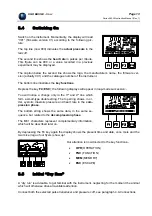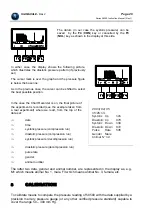
UGO BASILE - I
TALY
Page 16
Series 58000 Instruction Manual (Rev.1)
In fact, the respiration, the struggling and any other possible
noise
are linked to the size of the
animal. As a rule of thumb, larger the animal, lower the frequency of the artifacts.
To supply an order of magnitude, the high-pass filter, when the dog pulse is measured, is tuned
to 150 p.p.m. (pulses per minute), 300 for the rat, 450 for small rats or large mice, 600 for the
mouse. Select appropriate setting for your experimental paradigm.
6.1.4
Set Reverse Pressure
During the pressure measurement, the piston starts its reverse motion when the signal is below
one tenth of the starting signal. To speed up the test duration, it is possible to anticipate the pis-
ton reverse.
From the MAIN menu, depress
F1
(
OPR
), then
F2
(
MOD
) ,
then
F4
(
ESC
). The following display will appear.
From this menu stage, by acting on the arrows, set the
pressure value at which the reverse motion of the piston
should start, and confirm it by the
F3
(
OK
) key.
If this function is not required, depress
F4
(
NUL
).
6.1.5
Set Reverse Time
If you don’t select the above function and depress
F4
(
NUL
)
from the previous menu, the following display appears.
From this menu stage, by acting on the arrows, set the de-
lay of the piston reverse-motion, starting from the moment
when the signal reaches one tenth of the starting signal,
and confirm it by the
F3
(
OK
) key.
If this function is not required, depress
F4
(
NUL
).
7
TEST
MENU
First of all check that the cuff and the pulse transducer are properly fit to the tail of the animal.
The pressure measurement can be carried out either automatically or manually. During the auto-
matic measurement, the instrument considers only signals which match precise parameters.
The manual measurement is useful when the signal does not match the parameters required for
an automatic test and enables to see and modify the signal amplitude.
Start with the main menu and depress
F1
(
OPR
). Depress it again (
TES
).






























